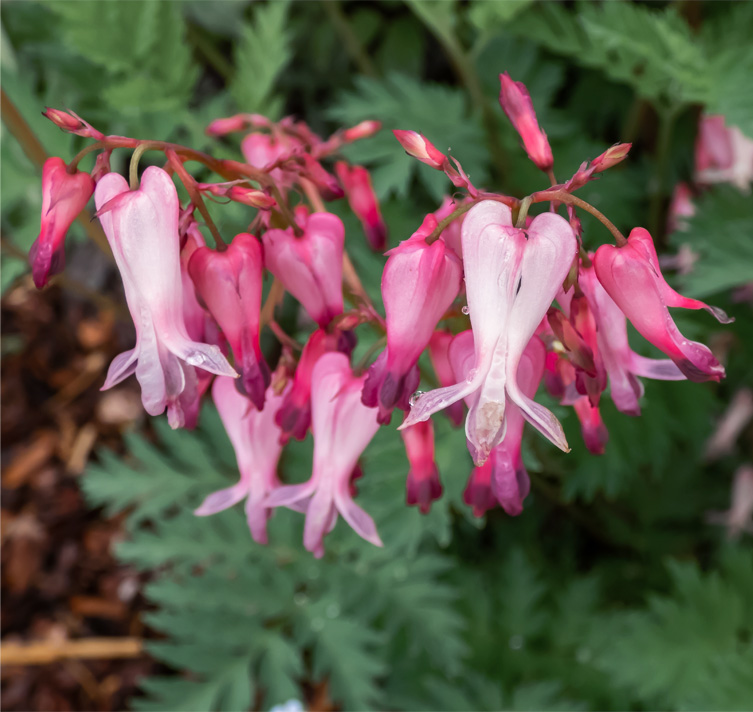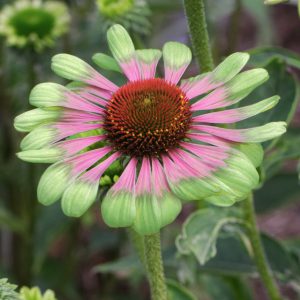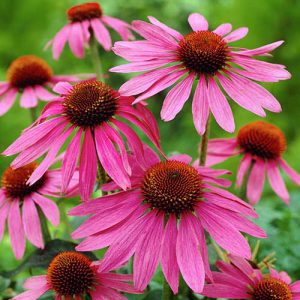- 1-9 pkts $4.50
- 10 pkts FREE
- Express post $12
Dicentra eximia
FRINGED BLEEDING HEARTS
Dicentra eximia is utterly charming, plus hardier and longer blooming than many other of the “Bleeding Heart” family.
Chains of heart shaped lockets
Dicentra eximia is a classic “Bleeding Heart” – flowering with chains of showy heart shaped blooms.
With the blooms dancing and dangling from arching stems, in large clusters like lockets on a chain.
Beautiful rose, soft, & shell pink hearts
The colouring of Dicentra eximia in bloom is exceptionally lovely.
With individual blooms within a cluster, varying from rich rose, to soft pink, to palest shell pink – dangling all together, in all shades, in every cluster.
With white & purple lips on each locket
Each heart shaped flower is also trimmed with white lips at the bottom (hence the name Fringed); and what appears to be a drop of purple blood in the centre (hence Bleeding Heart).
So the colouring of Dicentra eximia is just lovely.
Finely dissected, ferny grey-green foliage
Especially because the flower colours are so beautifully contrasted against grey-green foliage.
Leaves are finely divided, creating a ferny carpet – so Dicentra eximia is a garden asset for both colour and texture all year round.
Long blooming – spring summer & autumn
Dicentra eximia is very long blooming, and out-flowers just about every other member of the “Bleeding Heart” family.
It begins blooming in early spring, and continues popping with flower clusters into summer.
Then in more shaded, cooler positions – the flowers will continue over summer and on through autumn; while in hotter, drier positions blooming will stop during the heat of summer and then resume again in autumn.
Lovely clusters to pick for vases
Stems of Fringed Bleeding Heart make good cut flowers and a lovely addition to vases.
For flower farmers
Harvest when the first blooms in the cluster begin to open, and pick early in the day.
The plunge the stems into deep water to allow them to take up water before arranging.
Blooms have longest vase life when flower preservative is used in the vase water, though they last a good week just in ordinary water.
Decorative carpet under trees, shrubs & shade
Dicentra eximia loves carpeting under trees and shrubs, which is its natural habitat.
It is happy in full shade all day; dappled light under trees; or even a little morning sun.
But basically it thrives in shade, and even performs in deeper shade than most other flowering plants.
More water-wise Bleeding Heart
Many Bleeding Hearts have the reputation of being demanding for water and resentful of drier conditions.
But Dicentra eximia is made of tougher stuff, and naturally adapted to drier conditions than most of its cousins.
Frost hardy in winter plus adapted to summer humidity & heat
It is a native of woodland and scrubby areas down the eastern parts of North America.
In climates from cold frosty northern winters to hot, humid southern summers.
So Dicentra eximia can survive winter cold and frost down to -30°C, whilst also coping with summer humidity and heat (though out of direct sunlight under its tree cover).
It is noted as the most heat and humidity tolerant of all the “Bleeding Hearts”.
Enjoys acid to neutral soil & copes with clay
As a woodland dweller, Fringed Bleeding Heart relishes the natural leaf litter and mulch under trees and shrubs, and the acid to neutral soil pH.
Do not use lime, and let it live as a groundcover amongst the Camellias and Rhododendrons.
It relishes heavy and retentive soils such a clay and humus rich loam.
Beloved by bees, pollinators & native nectar loving birds
All our nectar loving friends are grateful to sip from the nectar-rich hearts of Dicentra eximia.
And they are especially grateful for the long-blooming period.
Rabbit & deer resistant
Happily rabbits and deer find the flowers and foliage distasteful.
They seem to know that that eating large quantities can have unhappy consequences, such as vomiting. Fortunately the taste is bitter – so eating lots is highly unlikely.
Compact, bushy perennial groudcover
Evergreen (though it will go dormant if summer is very dry as protection, and then bounce back with autumn moisture).
30cm. High with clusters of dangling heart shaped blooms x 60cm. Wide carpeting groundcover of dense ferny foliage.
SEED SOWING ADVICE: Warm – cold – cool.
Sow in winter or early spring.
First soak the seeds seed in fresh water for 12-24 hours (water that has been previously boiled in the kettle and allowed to cool is ideal.
Then rinse with more fresh water.
Then sow the seeds in a punnet on the surface of good quality seed raising mix.
Press gently and barely cover with sieved mix / fine vermiculite / or fine sandy grit, but only barely sprinkle.
As these seeds need light to germinate.
Now thoroughly moisten the punnet by standing it in a shallow water bath and allowing the moisture to percolate to the surface of the mic from below.
Now place in a warm, well-lit position (but not in any direct sunlight) for 2-4 weeks.
Temperatures of 18-22°C are best for this pre-conditioning period.
You can use a heat mat if you have one to maintain consistent warmth.
Continue to keep the punnet consistently moist by regularly misting from a spray water-bottle.
Covering the punnet with a clear plastic lid or plastic bag will help to maintain the necessary consistent moisture.
After the period of warm, moist pre-conditioning – now wrap the moist punnet in cling wrap or a plastic bag, and place in the fridge (not freezer) for 4-6 weeks.
Then after the period of chilling – now remove, unwrap, and place in a cool position (not in any direct sunlight).
Temperatures around 13°C are best for optimum germination (so winter sowing is best).
Then most seedlings should emerge in approx. 30 days. But do not discard as some seeds will continue to sprout.
Seed Count: 15 seeds per pack approx. (Seeds of this lovely Bleeding Heart are scarce).
Click here for Nursery Open Days & Open Gardens Information
https://www.gardivalia.com.au/open-gardens
Click here to go back to Seeds Shop
https://www.seedscape.net.au/shop/
Related products
-
Add to WishlistAlready In WishlistAdd to Wishlist
-
Add to WishlistAlready In WishlistAdd to Wishlist
-
Add to WishlistAlready In WishlistAdd to Wishlist
-
Add to WishlistAlready In WishlistAdd to Wishlist





